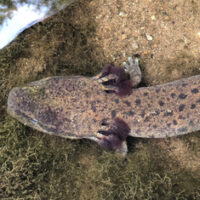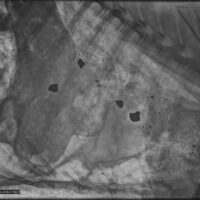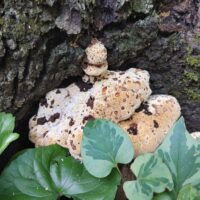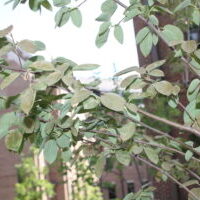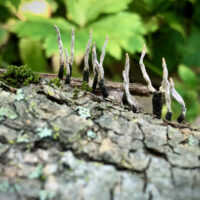 Purdue University - Extension - Forestry and Natural Resources
Purdue University - Extension - Forestry and Natural Resources
Got Nature? Blog
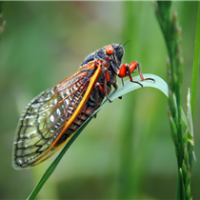 WRTV, Indianapolis News and Headlines: WEST LAFAYETTE — Elizabeth Long loves bugs.
WRTV, Indianapolis News and Headlines: WEST LAFAYETTE — Elizabeth Long loves bugs.
And she wants you to know that this summer is going to be huge for bug lovers, thanks to the emergence of two special broods of cicadas, which hasn’t happened in more than two centuries.
“That’s really, really exciting for these periodical cicadas, these two broods that are going to be emerging this year,” said Long, a Purdue University assistant professor of entomology.
“The big deal is the fact that they will be emerging in synchrony for the first time (since 1803). It’s a really long time.”
Long has a doctorate from the University of Missouri in plant, insect and microbial sciences and specializes in managing pests and beneficial bugs on farms and orchards.
And just how much does Long love bugs?
Well, she described the big green-and-black cicadas we see every summer in Central Indiana as “cute.”
“They’re green, they have a white belly,” she said. “I think they’re very cute. They’re very clumsy, you know.”
Long said these two broods of cicadas will be emerging in southern and northern parts of Indiana for about a month starting in May, then they’re gone.
WRTV asked Long about this summer’s ridiculously rare emergence of the 17-year Brood XIII (or Brood 13) and the 13-year Brood XIX (Brood 19) cicadas.
Question: What’s so special about the cicadas we are going to see this summer?
Long: We don’t have many insects that stay underground as immatures for this long, you know. It’s I think pretty amazing. So that’s really, really exciting for these periodical cicadas, these two broods that are going to be emerging this year. The big deal is the fact that they will be emerging in synchrony for the first time (since 1803). It’s a really long time.
The main difference between the two broods is the time that they spend (before) they emerge. So one is a 13-year brood and, it’s a little confusing because… the two broods that are going to emerge are Brood 19 (Brood XIX) and Brood 13 (Brood XIII).
Brood 19, which is just the number assigned to this group that emerges, those are 13 year cicadas… Then Brood 13, which is a little bit confusing… they emerge every 17 years.
So you can see that 13-17 overlap. That’s how we’re in that coincidence with the synchrony based on the math of them emerging both at the same time this year.
It so weird that 19 is 13 (years) and 13 is (17 years). I had to read up on it to get it straight.
WRTV: No wonder you guys have to get advanced degrees to understand bugs.
Long: Everyone thinks they’re simple… I’m like, these insects, they keep it challenging.
To see the full article, please visit WRTV Indianapolis News and Headlines.
Resources:
Periodical Cicadas, Indiana Department of Natural Resources, Division of Entomology
Billions of Cicadas Are Coming This Spring; What Does That Mean for Wildlife?, Got Nature? Blog, Purdue Extension-Forestry and Natural Resources (FNR)
17 Ways to Make the Most of the 17-year Cicada Emergence, Purdue College of Agriculture
Ask an Expert: Cicada Emergence Video, Got Nature? Blog, Purdue Extension-FNR
Periodical Cicada in Indiana, The Education Store, Purdue Extension resource center
Cicada Killers, The Education Store
Purdue Cicada Tracker, Purdue Extension-Master Gardener Program
Cicada, Youth and Entomology, Purdue Extension
Indiana Department of Entomology and Plant Pathology
Vic Ryckaert, Digital Reporter
WRTV Indianapolis
Elizabeth Y. Long, Assistant Professor
Purdue University Department of Entomology
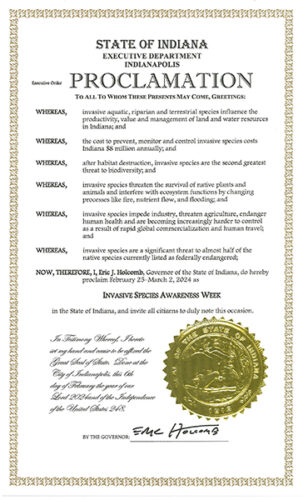 Governor Eric Holcomb has proclaimed February 25th to March 2nd as 2024 Invasive Species Awareness Week in Indiana.
Governor Eric Holcomb has proclaimed February 25th to March 2nd as 2024 Invasive Species Awareness Week in Indiana.
This serves as an important reminder for Hoosiers to be aware and report potentially devastating invasives.
This proclamation states “invasive aquatic, riparian and terrestrial species influence the productivity, value and management of land and water resources in Indiana and the cost to prevent, monitor and control invasive species costs Indiana millions annually and after habitat destruction, invasive species are a great threat to biodiversity and threaten the survival of native plants and animals and interfere with ecosystem functions by changing processes like fire, nutrient flow and flooding”.
It continues with “invasive species impede industry, threaten agriculture, endanger human health and are becoming increasingly harder to control as a result of rapid global commercialization and human travel; and invasive species are as significant threat to almost half of the native species currently listed as federally endangered.”
As Invasive Species Awareness Week starts Sunday, February 25th, the Indiana Department of Natural Resources (IN DNR), Purdue Extension-Forestry and Natural Resources and the Indiana Invasive Species Council will answer any questions you may have.
For Questions:
Ask an Expert, Purdue Extension-Forestry and Natural Resources
Invasive Species – Indiana Department of Natural Resources (IDNR)
Indiana Invasive Species Council – Includes: IDNR, Purdue Department of Entomology and Professional Partners
Cooperative Invasive Species Management Area (CISMA)
Report and Learn More About Invasive Species –
Great Lakes Early Detection Network App (GLEDN) – The Center for Invasive Species & Ecosystem Health
EDDMaps – Early Detection and Distribution Mapping System
Purdue University Report Invasive Species, College of Agriculture
Check Out Our Invasive Species Videos –
Subscribe: Purdue Extension-Forestry and Natural Resources (FNR) YouTube Channel
Invasive Species YouTube Video Playlist includes:
- Asian Bush Honeysuckle
- Burning Bush
- Callery Pear
- Multiflora Rose
- Invasive Plants Threaten Our Forests Part 1: Invasive Plant Species Identification
- Invasive Plants Threaten Our Forests Part 2: Control and Management
More Purdue Extension-FNR YouTube Video Series –
Woodland Management Moment:
Woodland Stewardship for Landowners:
ID That Tree:
More Resources –
FNR Extension Publications, The Education Store:
- Invasive Plant Species: Tree of Heaven
- Invasive Plant Species: Oriental Bittersweet
- Invasive Plant Species: Wintercreeper
- Japanese Chaff Flower
- Kudzu in Indiana
- Mile-a-minute Vine
Purdue Landscape Report:
FNR Extension Got Nature? Blog:
Don’t Miss These Resources:
Episode 11 – Exploring the challenges of Invasive Species, Habitat University-Natural Resource University
What Are Invasive Species and Why Should I Care?, Purdue Extension-FNR Got Nature? Blog
Emerald Ash Borer Information Network, Purdue University and Partners
Aquatic Invasive Species, Illinois-Indiana Sea Grant (IISG)
Invasive plants: impact on environment and people, The Education Store, Purdue Extension’s resource center
Purdue Extension-Forestry and Natural Resources
Wild Bulletin, Indiana Department of Natural Resources (DNR) Fish and Wildlife: The Division of Fish & Wildlife asks anglers to report sightings of the mudpuppy (Necturus maculosus) to help biologists track their populations across the state. A Species of Special Concern in Indiana, this salamander inhabits the state’s lakes and streams.
Mudpuppies, like fish, live their entire lives in water, but they are more secretive and difficult to locate. During winter, mudpuppies move into shallow water and are more frequently caught by anglers. They may also be viewed from shore using a flashlight at night, while they walk along the lake bottom. Mudpuppies are not dangerous or poisonous. They can be identified by the red, fluffy gills on the back of their head, but the gills tend to lay flat against their body when they are out of the water.
If you catch a mudpuppy while fishing, please photograph it, cut your fishing line, and release the mudpuppy back into the water. Report your observation to the DNR herpetologist at HerpSurveys@dnr.IN.gov and include a clear photograph of it, the date, and the location where it was found. The DNR appreciates your help tracking this unique salamander.
To learn more please visit DNR: Amphibians and Reptiles.
Resources:
Researchers Discover Young Hellbender in Blue River, Purdue Forestry and Natural Resources News & Stories
Help the Hellbender, North America’s Giant Salamander, The Education Store
Help the Hellbender, Purdue College of Agriculture
Question: Which salamander is this?, Got Nature? Blog, Purdue Extension – Forestry and Natural Resources
Is it a Hellbender or a Mudpuppy?, Got Nature? Blog
Amphibians: Frogs, Toads, and Salamanders, Purdue Nature of Teaching
A Moment in the Wild, Playlist, Purdue Extension – Forestry and Natural Resources
Help the Hellbender, Playlist & Website
The Nature of Teaching: Adaptations for Aquatic Amphibians, The Education Store, Purdue Extension resource center
Hellbenders Rock!, The Education Store
Indiana Department of Natural Resources
Wild Bulletin, Indiana Department of Natural Resources (DNR) Fish and Wildlife: Did you know that wild game shot with lead ammunition can sometimes contain lead fragments all the way to the dinner table? Adopting different shot placement and butchering techniques can help alleviate the problem.
When shooting: Avoid shooting animals in heavily boned areas, such as the front shoulders, as this is more likely to cause bullet fragmentation. Instead, shoot animals in softer tissue, such as around the heart and lungs, to decrease fragmentation.
When butchering: Carefully observe the wound channel in the animal and generously trim away any meat that shows bullet trauma. This will help keep fragments out of your finished meat product. Properly dispose of your trimmed meat by sending it to the local landfill or burying it on private property.
Looking for another way for you and your family to avoid ingesting lead fragments? Talk to your local retailer about finding a nontoxic ammunition that’s right for you.
To learn more please visit DNR: Effects of lead on wildlife.
Resources:
Hunting Guide for 2023-2024, Indiana Department of Natural Resources
How to Score Your White-tailed Deer, video, The Education Store, Purdue Extension Resource Center
White-Tailed Deer Post Harvest Collection, video, The Education Store
Age Determination in White-tailed Deer, video, The Education Store
How to Build a Plastic Mesh Deer Exclusion Fence, The Education Store
Managing Your Woods for White-Tailed Deer, The Education Store
Bovine Tuberculosis in Wild White-tailed Deer, The Education Store
Help With Wild Turkey Populations, Video, Purdue Extension – Forestry and Natural Resources YouTube Channel
Turkey Brood Reporting, Indiana Department of Natural Resources (IDNR)
Wild Turkey, Indiana Department of Natural Resources (IDNR)
Wild Turkey Hunting Biology and Management, Indian Department of Natural Resources (IDNR)
Subscribe to Purdue Extension-Forestry & Natural Resources YouTube Channel, Wildlife Playlist
Indiana Department of Natural Resources
Wild Bulletin, Indiana Department of Natural Resources (DNR) Fish and Wildlife: Indiana DNR has been working with neighboring states to address the invasive carp problem in our waters. The Kentucky Department of Fish and Wildlife Resources has been using contract fishers to harvest invasive carp from the middle Ohio River at the leading edge of invasive carp’s established population, and the Indiana Division of Fish & Wildlife provides support as needed. The contract fishing program will be operating through the winter and spring. Most fishing will occur from Leavenworth to Cannelton, Indiana, in small tributaries and backwaters off the Ohio River. Agency staff will ride along with contract fishers to collect data and ensure native fish populations are not negatively impacted.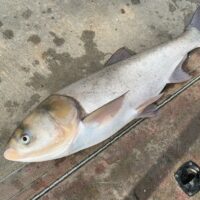
Throughout the year, biologists are involved in several other collaborative research and monitoring projects to slow the spread of invasive carp within the Ohio River basin. If you encounter an invasive carp and are wondering what to do with it, try eating it! Our website includes information on how to clean and prepare silver carp for a tasty meal, as well as descriptions of other DNR projects that address invasive carp.
To learn more please visit DNR: Invasive Carp.
Resources:
Asian carp solutions: Take them to market, Illinois-Indiana Sea Grant
Asian carp, Illinois-Indiana Sea Grant
Asian carp, Purdue College of Agriculture
Invasive Species, Playlist, Purdue Extension – FNR YouTube Channel
What are invasive species and why should I care?, Got Nature? Blog, Purdue Extension – Forestry and Natural Resources
Report Invasive Species, Purdue Invasive Species
Walleye Farmed Fish Fact Sheet, The Education Store, Purdue Extension’s resource center
Pacific White Shrimp Farmed Fact Sheet, The Education Store
Yellow Perch Farmed Fish Fact Sheet, The Education Store
Tilapia Farmed Fish Fact Sheet, The Education Store
Rainbow Trout Farmed Fish Fact Sheet, The Education Store
American Paddlefish, The Education Store
A Guide to Small-Scale Fish Processing Using Local Kitchen Facilities, The Education Store
Eat Midwest Fish, Illinois-Indiana Sea Grant online resource hub
Indiana Department of Natural Resources
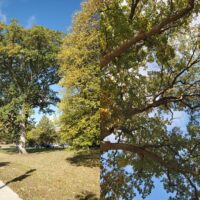
Figure 1: Mature oak tree known to be infected by Inonotus dryadeus on Purdue University West Lafayette campus. Right image shows limb death suggestive of tree decline.
Purdue Landscape Report: Inonotus dryadeus is one of the more common wood decay fungi we receive at the diagnostic lab in association with declining trees, specifically oaks. Inonotus is found so frequently on oaks it has the common name oak bracket fungus, but it can cause root rot of a number of other hardwood trees (including maples, sweet gum, buckeyes, chestnut, and ash) and conifers (fir, pines, spruce, and hemlock – mostly in western US).
Similar to other butt and root rots of trees, Inonotus causes internal decay near the base of the tree. Trees may not show any external symptoms while there is a raging root rot decaying everything holding it up, eventually leading to an unexpected failure of the tree during a windstorm. Trees with compromised root systems may also die suddenly during hot and dry weather. Most often, we see a gradual decline of infected trees with stunted growth, limb dieback, and/or sparse, off-color foliage; symptoms that may accelerate during adverse environmental conditions (Figure 1).
The only good thing about this fungus is that it is somewhat easy to identify. Inonotus produces a round to irregularly-shaped conk like structure each year from colonized host tissue, such as exposed roots, the trunk at the soil-line, or lower trunk (Figure 2). When it is young the conk is yellow to orange on the upper surface and white on the underside. Pores in the upper surface of the conk producing amber colored liquid can also be found earlier in the spring and early summer, lending to its other common name the weeping conk (Figure 3).
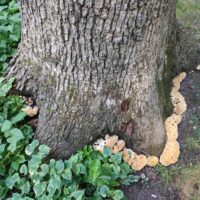
Figure 2: Extensive growth of Inonotus dryadeus from the base of an oak tree. The tree had significant limb dieback, was at risk of falling over, and subsequently removed.
To view this full article and other Purdue Landscape Report articles, please visit Purdue Landscape Report.
Subscribe and receive the newsletter: Purdue Landscape Report Newsletter.
Resources:
Root Rot in Landscape Plants, The Education Store, Purdue Extension resource center
Dead Man’s Fingers, Purdue Landscape Report
ID That Tree Fall Color: Sugar Maple, Purdue Extension – Forestry and Natural Resources (FNR) YouTube Channel
ID That Tree Fall Color Edition: Black Gum, Purdue Extension – FNR YouTube Channel
An Introduction to Trees of Indiana, The Education Store
Autumn Highlights Tour – South Campus, Purdue Arboretum Explorer
Subscribe, Purdue Extension – FNR YouTube Channel
Tree Defect Identification, The Education Store
Tree Wound and Healing, Got Nature? Blog, Purdue Extension – FNR
Shrubs and Woody Vines of Indiana and the Midwest, The Education Store
Ask an Expert: Tree Selection and Planting, Purdue Extension – FNR YouTube playlist
ID That Tree, Purdue Extension – FNR YouTube playlist
Invasive Species, Playlist, Purdue Extension – FNR YouTube Channel
Report Invasive Species, Purdue Invasive Species
Find an Arborist, International Society of Arboriculture
John Bonkowski, Plant Disease Diagnostician
Departments of Botany & Plant Pathology
Purdue Landscape Report: Mites are eight-legged arthropods who pierce plant cells to feed on them. Plants that are attacked by mites lose their green color and appear somewhat bronzed. Spider mites will make webs to help them forage on leaves unencumbered by irregular leaf surfaces. The accumulation of webs, and old skins of mites can give heavily infested plants a dusty appearance. This can make plants unsightly and affect their health.
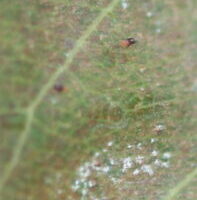
Figure 2. This serviceberry leaf has live European red mites, eggs and old shed skins that accumulate on the leaf.
Lack of rain this summer and fall has spared spider mites from drowning and being washed off leaves during heavy rains. Warm weather in late August and September allowed warm season mites, like two spotted spider mite, European red mite on flowering fruit trees, honeylocust, maple and oak spider mites to flourish. With the daily highs consistently below 85 F, cool season mites like spruce spider mite, boxwood spider mite and southern read mite have been increasing in number.
Now would be a good time to take stock of which plants have spider mites to help you plan your control strategy.
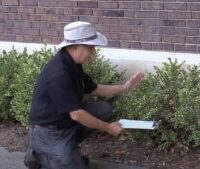
Figure 3. Tap the branches over a white sheet of paper. After giving the mites 10 seconds to grab hold of the paper, turn the sheet sideways to let the debris fall off. Then examine the specs to determine if they are spider mites. A 10X hand lens or smartphone can help you see these small pests.
Cool season mites, including southern red mite, boxwood spider mite and spruce spider mite may require treatment this fall to keep their populations from building. This could be accomplished with a garden hose and a strong stream of water or a 2% solution of horticultural oil or insecticidal soap.
At this point in the season, there is usually no need to spray trees for warm season spider mites. Because most spider mites will winter on trees and shrubs, these mite infested trees can be targeted for a spray of oil during the dormant season. It is important to note that plants with two spotted spider mites will not benefit from an oil spray because they winter in the ground cover. Also, be sure not to spray oil on shrubs with waxy blue leaves. This wax often protects plant leaves from strong winds and sun in the winter.
To view this full article and other Purdue Landscape Report articles, please visit Purdue Landscape Report.
Subscribe and receive the newsletter: Purdue Landscape Report Newsletter.
Resources:
Managing Spider Mite Mayhem with the Purdue Plant Doctor, Purdue Extension Entomology YouTube Channel
Purdue Plant Doctor Website
Spider Mites On Ornamentals, Purdue Extension Entomology Bulletin
Tree Defect Identification, The Education Store
Tree wounds and healing, Got Nature? Blog
Tree Risk Management, The Education Store
Why Is My Tree Dying?, The Education Store
The Woody Plant Seed Manual, U.S. Forest Service
Native Trees of the Midwest, The Education Store
Invasive Species, Playlist, Purdue Extension – FNR YouTube Channel
Report Invasive Species, Purdue Invasive Species
Find an Arborist, International Society of Arboriculture
Subscribe Purdue Extension-Forestry and Natural Resources YouTube Channel
Cliff Sadof, Professor and Extension Fellow
Purdue Entomology
Purdue Landscape Report: Dead man’s fingers is an apt moniker for a gruesome-looking fungus (Xylaria polymorpha and related species) that produces club-shaped fungal fruiting bodies that appear as fingers growing around the base of dying or dead woody plants and even wooden objects in soil (Fig. 1). With more than 25 species of Xylaria, generalizations are difficult to make (Fig. 2), but we will persevere anyways, recognizing that some Xylaria species are limited to a saprophytic existence decomposing wood (like X. polymorpha) while others, like X. mali, cause an opportunistic black root rot on apple and crabapple (Rogers, 1984; Rogers and Callen, 1986) or nothing at all (Fig. 2). Other Xylaria species infect Norway maple, honey-locust, elm and pears (flowering and edible). Perhaps the scariest thing about dead man’s fingers is its taxonomy: X. polymorpha is an extremely variable and complicated species showing “multiple interfaces and intergradations with numerous other taxa” making speciation a challenge (Lee et al, 2000), which may explain why a crabapple with a bad graft union covered in dead man’s fingers looks otherwise healthy!
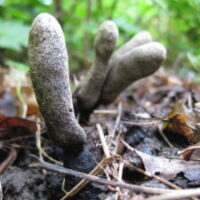
Figure 1. Dead man’s fingers is an apt moniker to describe the fruiting body of Xylaria species. Photo by Janna Beckerman.
Symptoms and Signs
Symptoms of infection by Xylaria may appear as stress and decline, including slowed growth, dieback, premature autumn coloration and leaf drop, and even crown or structural root cankers. Apple, crabapple or pear trees infected may produce an unusually large crop of undersized fruit.
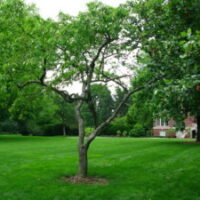
Figure 3a. Dead man’s fingers can be found associated with otherwise healthy, asymptomatic trees, or simply growing on dead wood—not necessarily causing disease.
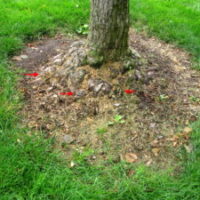
3b. Close-up of the rootstock with multiple croppings of Xylaria on the crown. Photo by Janna Beckerman.
Signs of Xylaria are more readily identified—namely, the dead man’s fingers (Fig. 4)! The club shaped, fingerlike fruiting bodies appear singularly or as clustered “fingers” about 1- 4 inches high, often at the base of infected or dying trees, or nearby large structural roots (Fig 4). In the spring, ascospores are produced by the “fingers”, creating a bluish bloom on the tips of the fingers. Cutting into a finger reveals a white interior with black bubbles that produce the sexual spores (ascospores). The “fingers” can release these spores for several months or years. In the spring, Xylaria can produce asexual spores (called conidia) anywhere on its surface, while also producing threadlike structures (called hyphae) that grow through dead or dying wood. Xylaria can survive as hyphae in roots for up to 10 years and can spread from plant to plant via hyphae when plant roots contact each other.
To view this full article and other Purdue Landscape Report articles, please visit Purdue Landscape Report
Subscribe and receive the newsletter: Purdue Landscape Report Newsletter.
Resources:
Tree Defect Identification, The Education Store
Tree wounds and healing, Got Nature? Blog
Tree Risk Management, The Education Store
Why Is My Tree Dying?, The Education Store
The Woody Plant Seed Manual, U.S. Forest Service
Native Trees of the Midwest, The Education Store
Invasive Species, Playlist, Purdue Extension – FNR YouTube Channel
Report Invasive Species, Purdue Invasive Species
Find an Arborist, International Society of Arboriculture
Subscribe Purdue Extension-Forestry and Natural Resources YouTube Channel
Janna Beckerman, Professor of Plant Pathology
Purdue Department of Botany
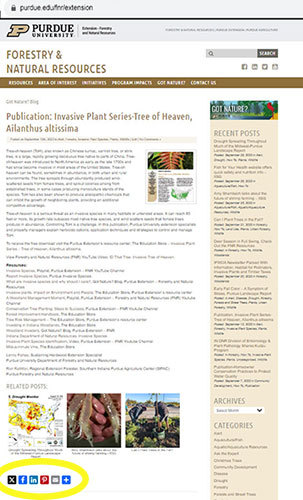 The Purdue Extension – Forestry & Natural Resources (FNR) team would like to take this time to thank our followers for their requests and comments. We received requests to improve our Purdue Extension – FNR’s Got Nature? Blog social media buttons and we would like to announce they are ready for you to share our articles. You can easily share the blog articles to X-Twitter, Facebook, LinkedIn, and Pinterest, along with an Email option.
The Purdue Extension – Forestry & Natural Resources (FNR) team would like to take this time to thank our followers for their requests and comments. We received requests to improve our Purdue Extension – FNR’s Got Nature? Blog social media buttons and we would like to announce they are ready for you to share our articles. You can easily share the blog articles to X-Twitter, Facebook, LinkedIn, and Pinterest, along with an Email option.
The Got Nature? Blog was started 11 years ago to allow the FNR Extension team to share aquatic, forestry, natural resources, wildlife, urban forestry and wood products hot topics along with answering any questions regarding these areas. The blog producer Diana Evans, Web and Extension Specialist, has been with the blog from the start. The Got Nature? blog has had over 166,000 web visits in the past three years.
If you have a natural resource topic you would like to hear from our experts about, fill out our quick and easy Contact Us form.
Subscribe to our Got Nature? e-newsletter and receive our resources and updates. All email addresses are secure and only used for the Purdue Extension – Forestry and Natural Resources’ Got Nature? newsletter mailing.
What is Purdue Extension-Forestry and Natural Resources (FNR)?
Purdue Extension – FNR is a part of a larger group, the Cooperative Extension Service (CES), one of the nation’s largest and best-researched providers of science-based information and education. Purdue Extension delivers practical, research-based information and provides high-impact educational programs that enhance lives and livelihoods.
Resources:
Subscribe to Purdue Extension-FNR YouTube Channel
ID That Tree, Purdue Extension-Forestry & Natural Resources (FNR) YouTube playlist
Woodland Management Moment, Purdue Extension-FNR YouTube playlist
Ask An Expert Playlist, Purdue Extension – Forestry and Natural Resources (FNR) YouTube Channel
Wildlife Habitat Hint Playlist, Purdue Extension – FNR YouTube Channel
Subscribe to the Purdue Extension – Forestry and Natural Resources YouTube Channel
Diana Evans, Extension & Web Communications Specialist
Purdue University Department of Forestry and Natural Resources
This one-day workshop will focus on aquaponics in the classroom. Topics that will be covered include fish culture basics, plant culture, water quality, systems, and more. 
Workshop Participants will:
- Participate in hands-on activities.
- Learn about IISG’s NEW aquaponics curriculum.
- Tour the High School for Ag Sciences aquaponics space.
- Become eligible for a new IISG loan program.
- Hear about IISG programs.
- Be inspired to incorporate aquaponics in the classroom.
Date: Saturday, November 4, 2023
Time: 9 AM – 5 PM Central (CST)
Location: Chicago High School for Agricultural Sciences, 3857 West 111th Street, Chicago, IL, 60655
Program partners include Illinois-Indiana Sea Grant, the Center for Great Lakes Literacy, the Indiana Aquaculture Association, University of Illinois Extension, and Purdue University’s Department of Forestry and Natural Resources.
To learn more about this event and how to register please visit Purdue Extension – Forestry & Natural Resources (FNR) Events.
What is Aquaponics: Fish and Plants Grow Sustainabley Through Aquaponics, IISG Newsroom
About IISG: These are trying times for the environment. Climate change and other concerns such as population growth, aquatic invasive species, contaminated waters, and loss of natural habitat, the southern Lake Michigan region faces many challenges. Illinois-Indiana Sea Grant (IISG), with its unique mandate to bring the latest science to those who can best use the information, serves a critical role in empowering people to solve problems in sustainable ways. The program is funded through National Oceanic and Atmospheric Administration (NOAA), the University of Illinois and Purdue University, but IISG also works in partnerships with key organizations, institutions, and agencies in the region to reach more audiences and multiply opportunities for success. IISG brings together scientists, educators, policy makers, community decision makers, outreach specialists, business leaders, and the general public to work towards a healthy environment and economy.
Resources:
Walleye Farmed Fish Fact Sheet, The Education Store, Purdue Extension’s resource center
Freshwater Prawn Farmed Fish Fact Sheet, The Education Store
Adaptations for Aquatic Amphibians, The Nature of Teaching, Purdue Extension – Forestry and Natural Resources (FNR)
Purdue Extension
Sustainable Aquaculture: What does it mean to you?, The Education Store
A Guide to Small-Scale Fish Processing Using Local Kitchen Facilities, The Education Store
Aquaculture Industry in Indiana Growing, Purdue Today
Purdue Aquaponics: Cut Water Usage, Purdue University YouTube Channel
Largemouth Bass Market Trends, Purdue Extension – FNR YouTube Channel
Amy Shambach, Aquaculture Marketing Outreach Associate
Purdue Department of Forestry and Natural Resources/Illinois-Indiana Sea Grant Program
Andrew Coursey, Aquaculture Specialist
Illinois-Indiana Sea Grant Program
Recent Posts
- IN DNR Deer Updates – Epizootic Hemorrhagic Disease Detected in Several Areas in Indiana
Posted: October 16, 2024 in Alert, Disease, Forestry, How To, Wildlife, Woodlands - Flying Into July: Bird Banding Season Begins – MyDNR
Posted: August 6, 2024 in Alert, Forestry, Wildlife - 2024 Turkey Brood Count Wants your Observations – MyDNR
Posted: June 28, 2024 in Alert, Community Development, Wildlife - Spongy Moth in Spring Time – Purdue Landscape Report
Posted: June 3, 2024 in Alert, Forestry, Forests and Street Trees, How To, Invasive Insects, Urban Forestry - MyDNR – First positive case of chronic wasting disease in Indiana
Posted: April 29, 2024 in Alert, Disease, How To, Safety, Wildlife - Report Spotted Lanternfly – Purdue Landscape Report
Posted: April 10, 2024 in Alert, Forestry, Invasive Insects, Plants, Wildlife, Woodlands - Declining Pines of the White Variety – Purdue Landscape Report
Posted: in Alert, Disease, Forestry, Plants, Wildlife, Woodlands - Are you seeing nests of our state endangered swan? – Wild Bulletin
Posted: April 9, 2024 in Alert, Forestry, How To, Wildlife - 2024-25 Fishing Guide now available – Wild Bulletin
Posted: April 4, 2024 in Alert, Aquaculture/Fish, Aquatic/Aquaculture Resources, How To, Ponds, Wildlife - Look Out for Invasive Carp in Your Bait Bucket – Wild Bulletin
Posted: March 31, 2024 in Alert, Aquaculture/Fish, Aquatic/Aquaculture Resources, Invasive Animal Species, Wildlife
Archives
Categories
- Alert
- Aquaculture/Fish
- Aquatic/Aquaculture Resources
- Ask the Expert
- Christmas Trees
- Community Development
- Disease
- Drought
- Forestry
- Forests and Street Trees
- Gardening
- Got Nature for Kids
- Great Lakes
- How To
- Invasive Animal Species
- Invasive Insects
- Invasive Plant Species
- Land Use
- Natural Resource Planning
- Nature of Teaching
- Plants
- Podcasts
- Ponds
- Publication
- Safety
- Spiders
- Timber Marketing
- Uncategorized
- Urban Forestry
- Webinar
- Wildlife
- Wood Products/Manufacturing
- Woodland Management Moment
- Woodlands
